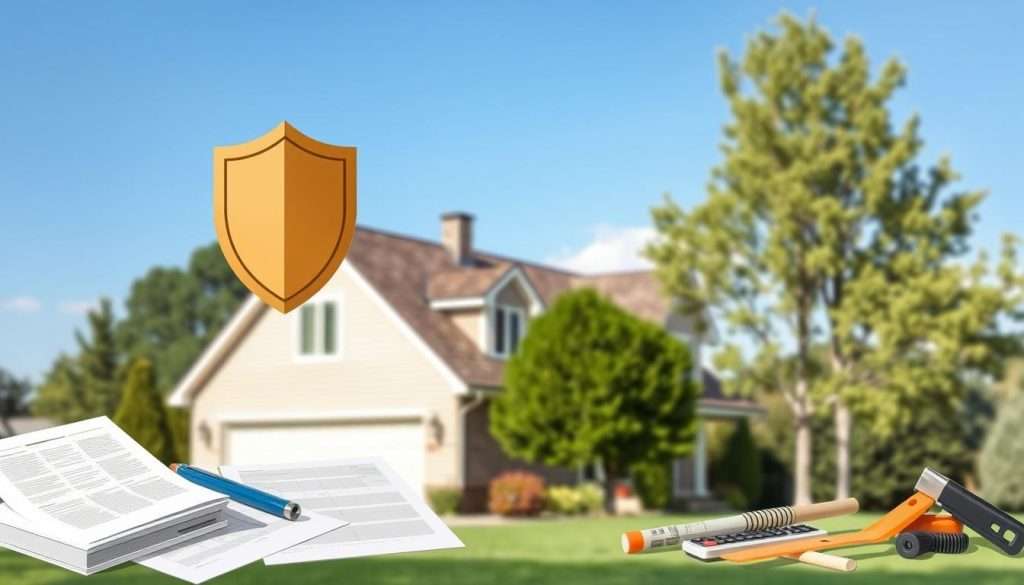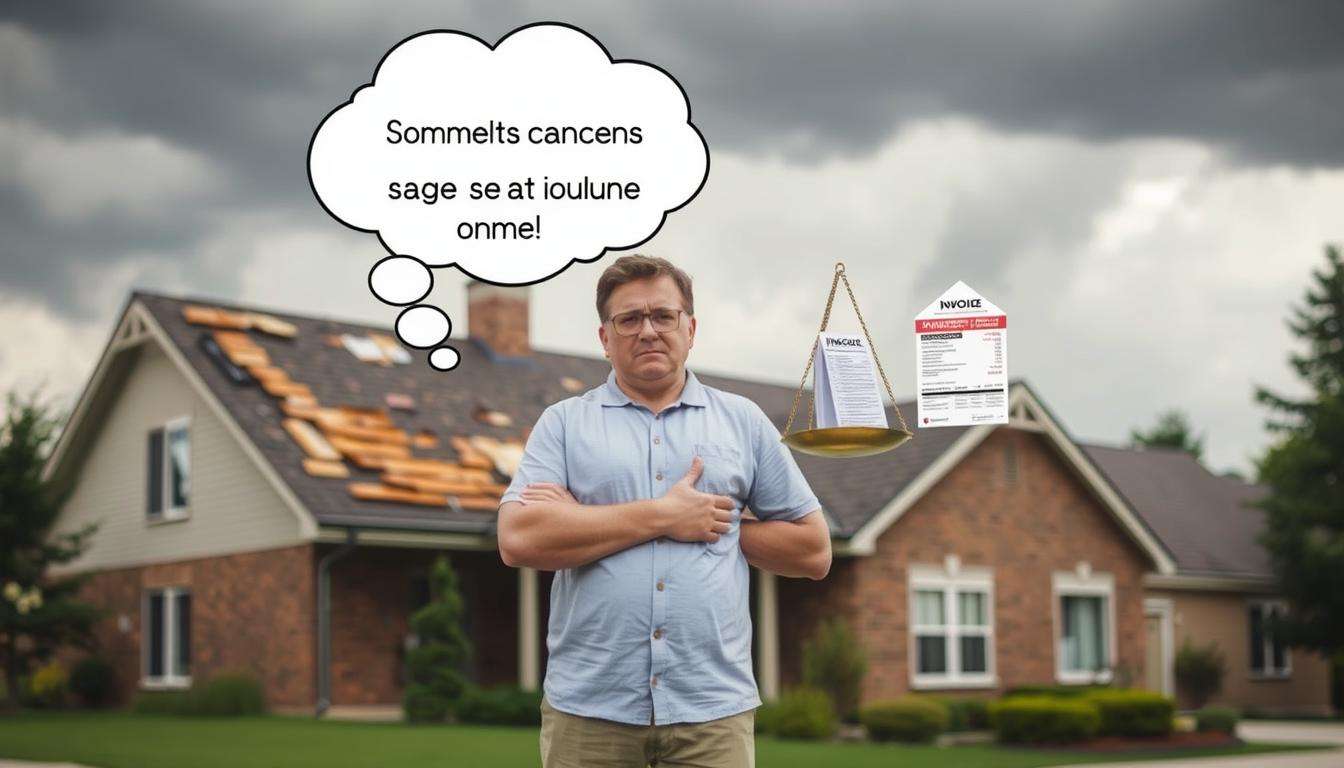Being a homeowner means you have many duties. Knowing how filing a roof claim might affect your insurance is key. Homeowners often worry, “Will my insurance go up if I file a roof claim?” It’s true that filing a claim can change your insurance costs.
The homeowners insurance roof claim impact depends on many things. For example, claims from big storms might raise rates for many people. Studies show that one claim can make your premium go up by 9-15% on average.
Also, if you file claims often, your insurance company might see you as a bigger risk. This could even lead to them canceling your policy. So, before you decide to file a claim, think about the damage’s severity. It’s also smart to talk to a roofing expert first.
Understanding Homeowners Insurance Basics
Homeowners insurance is key to protect your home from risks. It helps you financially when bad things happen. Knowing about homeowners insurance can help you understand your policy better.
What is Homeowners Insurance?
Homeowners insurance is a type of insurance for your home. It covers damage to your house and things inside. It also protects you if someone gets hurt on your property. Knowing this helps you make smart choices when you need it.
Key Components of a Policy
Home insurance policies have important parts:
- Dwelling Coverage: This part protects your home’s structure from damage.
- Personal Property Coverage: It covers your stuff if it gets stolen or damaged.
- Liability Coverage: This part helps if someone gets hurt on your property.
Knowing these parts helps you understand your policy. It also helps when you need to file a claim.
Common Coverage Areas
Home insurance usually covers roof damage from:
- Severe weather like hail or strong winds
- Falling trees or branches
- Vandalism or theft that damages the roof
It’s important to know what your policy covers. This is especially true if you have big roof problems that might need a claim.

Factors Affecting Insurance Premiums
Knowing what factors affecting insurance premiums is key for homeowners. This is especially true when thinking about filing a roof claim. The type of claim greatly affects insurance rates. Different situations can change rates in different ways.
Type of Claim and Its Impact
The type of claim and insurance rates are very important. Claims from natural disasters, like hurricanes, can raise rates a lot. But, small claims for minor fixes might not affect rates as much.
Insurers look at how often and how severe these claims are. This helps them figure out how much to charge homeowners in certain areas.
The Role of Claim Frequency
Homeowners need to know how claim frequency and premium changes work. If you file claims often, your rates might go up. Even claims that don’t cost you money can still make you seem riskier to insurers.
This can lead to higher rates when it’s time to renew your policy. It’s important to think about this when you file a claim.
Geographic Risk Factors
Also, geographic risk factors affecting homeowners insurance are big. Places prone to disasters, like wildfires or tornadoes, have higher premiums. The cost of living and repair costs in your area also play a part.
Homeowners in high-risk areas should be ready for possible rate changes. Insurers look at the risks in your area when deciding on rates.
How Filing a Roof Claim Can Impact Premiums
When you think about filing a roof claim, knowing how it might change your premiums is key. Filing a claim can surprise homeowners with sudden cost increases. These costs can last a long time. This part talks about the quick and long-term effects and how deductibles affect your insurance.
Immediate Effects on Your Premium
Filing a roof claim can change your insurance premium right away. Homeowners often see a 9-15% increase after their first claim. This increase comes from:
- The severity of the roof damage
- The cost of repairs
- If the damage is from covered events like hail or wind
One claim can make you seem riskier to insurers. This might lead to more policy checks.
Long-term Implications for Coverage
Claims can affect your insurance rates for a long time. Each claim you file stays on record, affecting your premiums for years. Insurers might change your rates based on your claim history. This can lead to:
- Higher premiums over time
- Loss of discounts
- Harder to find affordable coverage later
The Influence of Deductibles
Deductibles are key in your insurance plan. Higher deductibles mean lower premiums but more costs when you file a claim. Think about:
- Higher Deductibles: Lower premiums but more money out of pocket if damage happens.
- Lower Deductibles: Higher premiums but less upfront cost when filing a claim.
Choosing the right deductible balance is important. It depends on your finances and how much risk you can handle. Knowing this helps you make smart insurance choices.

| Claim Type | Immediate Premium Impact | Long-term Premium Consideration | Deductible Influence |
|---|---|---|---|
| Hail Damage | 9-15% increase | Higher risk profile | Higher deductible = lower premium |
| Wind Damage | Similar to hail | Multiple claims mean bigger increases | Lower deductible = higher premium |
| Tree Limb Fall | Dependent on damage cost | Severe claims raise risk | Risk assessment varies with high-value properties |
When to File a Roof Claim
Knowing when to file a roof claim can save you money. It also protects your investment. First, check the damage’s severity. See if it meets your insurance policy’s criteria. A small leak might not need a claim, but big damage after a storm might.
Assessing Damage: Is It Severe Enough?
Before filing a roof claim, check the damage well. Small problems that cost less than your deductible might not be worth a claim. Think about these points:
- Is the damage just a few shingles, or is it all over?
- Can you see water getting into your home?
- Will fixing it cost more than your deductible?
Weighing Repair Costs vs. Premium Increase
When deciding, compare repair costs to insurance rate changes. If fixing it costs less than what you could lose in discounts, pay for it yourself. Remember, filing claims after big damage can raise your rates. This is especially true if you file often.
Timing Your Claim Wisely
The right time to file your claim is important. Filing quickly after a storm helps. Talk to your insurance company to understand rate changes. They can help you decide when to file.
Also, get help from roofers who know insurance well. They can make sure your claim is handled right.
Alternatives to Filing a Claim
Before you decide to file a roof claim, look at alternatives to filing a claim. You might use your savings for roof repairs if the damage is small. This way, you can avoid higher premiums later.
Every homeowner wants to keep their insurance affordable. Sometimes, a small savings investment can help keep your policy good.
Exploring Internal Savings for Repairs
Using your savings helps with immediate repair needs. It also keeps your claim-free history. If repairs cost more than your deductible, it might be better to pay yourself.
This choice gives you control and avoids future insurance problems.
Utilizing Home Warranty Options
Look into your home warranty options for roof damage. Many home warranties cover repairs without involving your insurance. This can be a hassle-free way to fix unexpected problems.
Depending on your policy, it might also help keep your premiums low.
Neighboring Insurance Products to Consider
Also, check out insurance products for homeowners that might be better for you. There are many options in the market. You might find one that fits your financial goals and situation better.
Being informed helps you make choices that fit your maintenance and financial plans. For more on filing claims and their effects, see this: Will My Homeowners Insurance Go Up If I File a.
